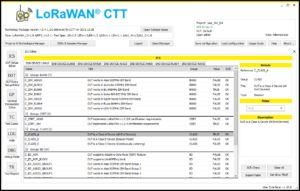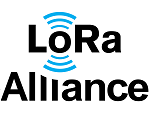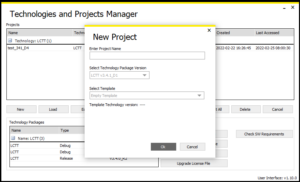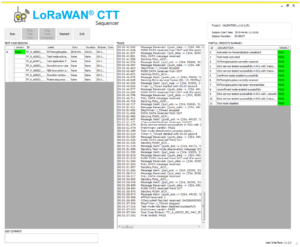LoRaWAN certification is the solution for successfully scaling long-range, low-power end-devices for IoT. The LoRaWAN Certification Test Tool (LCTT) accelerates time to market through test automation.
To successfully scale IoT over billions of devices, end-users need confidence that their devices will operate correctly. That’s where the need for industry standards comes in. The LoRa Alliance, which develops and maintains the LoRaWAN open standard, offers simple and inexpensive pre-certification testing reduce the time to certify end-devices. Manufacturers can now perform this testing, which lets them debug prior to pursuing formal certification at an authorized test house.
Before diving into LoRaWAN certification and testing, we’ll explain the need to understand how LoRa, LoRaWAN, and the certification program relate to each other.
LoRa, the physical layer
LoRa is the chirp spread spectrum (CSS) modulation-based physical layer for wireless communication. It’s the basis of the physical radio and hardware that you need to enable long-range connectivity for massive IoT use cases.
LoRaWAN, end-to-end architecture and protocols
LoRaWAN is a low-power, wide-area networking (LPWAN) protocol family that wirelessly connects battery-operated “things” to the internet in local, regional, national, or global networks. LoRaWAN’s standard benefits include long battery life, deep signal penetration, choice of network type and business model, full control of data and security, firmware updates over the air (FUOTA), and much more. LoRaWAN is now an official standard accepted by ITU-T, a global standards organization.
LoRa Alliance certification program
The LoRa Alliance offers the LoRaWAN Certification Program to ensure connectivity and interoperability between end-devices to LoRaWAN networks. LoRaWAN Certified devices are tested for conformance, security, and interoperability.

Figure 1. The LoRaWAN architecture consists of layers from the physical radio through application layers. Services communicate with IoT devices through servers and gateways.
As Figure 1 shows, using LoRa (the RF physical layer) with LoRaWAN (the L2 protocol layer) and the Alliance’s regional parameters allows interoperability across networks according to the local ISM regulations and makes global networking possible.
LoRaWAN Certified Test Tool (LCTT)
Technology certification can be time consuming, rife with mistakes, and may require more than one pass. The LoRaWAN Certification Test Tool (LCTT) was designed for LoRa Alliance members to overcome these barriers to certification, thus significantly reducing time, cost and mistakes.

Figure 2. The LoWaRAN Certification Test Tool takes engineers through the LoRaWAN certification process.
The LCTT can be used at a device manufacturer’s facility, letting engineers fully test and regression test devices. Such testing lets engineers debug and make design tweaks before the formal certification process. Certification testing assures LoRaWAN network operators and end-users that devices attain the required quality and reliability to work on any LoRaWAN network out of the box. Figure 2 highlights the certification process.
Recently, the LoRaWAN Alliance released a new version of the LCTT, which adds additional testing capabilities. Specifically, validation of:
-

Figure 3. The LCTT main screen lets engineers set up precompliance tests in their own lab before going to a certification lab.
LoRaWAN Class A, B and C end-device functionality (Figure 3) selected based on the application requirements: All devices must support Class A communication, the lowest power bi-directional communication initiated by the end-device, followed by two short downlink (i.e., reception) windows. Class B devices are bi-directional with deterministic downlink latency and are synchronized to the network using periodic beacons. The network can send downlink communications with a deterministic latency but use additional power consumption in the end-device. Class C supports the lowest latency bi-directional end-devices and keeps the receiver of the end-device open. The network server can initiate a downlink transmission any time, making class C suitable for applications with continuous power.
- Long range frequency hopping spread spectrum (LR-FHSS) data rates for the EU868, US915, and AU915 regions: LR-FHSS data rates significantly increase network capacity in certain scenarios while maintaining LoRaWAN’s low-power consumption. They are used for uplink only; standard data rates remain in use for the downlink.
- Back-off retransmissions that prevent a radio network overload. Uplink frames require an acknowledgment or answer from the network; if not received, messages are retransmitted by the end-device. They can also be triggered by an external event causing synchronization across many devices (>100).
- Regional parameters: radio frequencies often have geographic region-specific restrictions including physical layer parameters such as frequency plans, mandatory channel frequencies, and data rates for join-request messages, as well as LoRaWAN layer parameters, including maximum payload size.
- End-device activation: every end device must register with a network to send and receive messages. The LCTT tests: 1) over-the-air-activation (OTAA), which involves devices performing a join procedure with the network, during which the network assigns a dynamic device address. Cryptographic session keys are negotiated between the device and the network; and 2) activation by personalization (ABP), which involves hardcoding the device address and session keys.
- Adaptive data rates (ADRs): This feature is used by network servers to adapt and optimize the number of retransmissions, the data rate, and the transmission power of end-devices. When ADR is enabled, end devices will be optimized to use the fastest data rate and minimum possible transmission power.
- End-device is operating at the correct power level through transmit power control: This capability is region-specific and encoded in the LoRaWAN Regional Parameters document. The transmit output power indicated in the command is considered the maximum transmit power at which the end-device may operate.
- Confirmed and unconfirmed frame functionality: LoRaWAN allows for unconfirmed or confirmed messages from end-devices to the network and application servers and vice versa. Unconfirmed message don’t require an acknowledgement from the server as where confirmed message do.
- Proper opening of receive windows following each uplink transmission to allow bi-directional communications: When correctly implemented, an end-device should open one or two receive windows following an uplink transmission to receive transmissions.
- Validating LoRaWAN security by verifying that advanced encryption standard (AES) encryption and message integrity code (MIC) algorithms are correctly implemented: Multiple messages with varying length payloads are sent to the end device to test the decryption of the message. If successfully received, the device generates messages with varying payloads and checks that they are encrypted correctly. The MIC frame signature is computed over the entire frame, which guarantees that the frame can’t be modified between the end-device and the network server without compromising this signature.
- The ability to add/modify channels: The LCTT validates that a network server can create a new bidirectional channel and modify the parameters of an existing one. The command sets the center frequency of the new channel and the range of uplink data rates that are usable on the channel.
- End device support for uplink retransmission of confirmed frames: If an end devices sends a confirmed uplink frame containing important information that must get through, it will continue to resend it until the network server sends a downlink acknowledgment that it has been received.
LoRaWAN Certification also defines certification by similarity, a shorter and less expensive path to certification, that allows businesses to leverage the certified status of another end-device, even if that end-device is made by another manufacturer. The time to certify is a few workdays, reducing the time and cost of the testing cycle. The LCTT validates that the end-device uses the same version of LoRaWAN and regional parameters.
What does using the LCTT look like?
Once installed, the latest technology package of the LCTT will automatically download to the tool to ensure that any pre-certification testing is done against the latest certification test specification.
The next step is to set up the test project. (Figure 4)

Figure 5. The LCTT main management interface lets engineers enter data about the DUT and select tests.
Once the project is created, give the LCTT information about the device on the main management interface with the buttons of the left side. These give access to the most common actions and tests in the application. See Figure 5.
From here, actions to be performed include:
- Device under test (DUT) Setup Editor contains project name, DUT name, logged user and role.
- DUT Extra Setup Editor allows modifying implementation extra information for testing (IXIT) and must be set up with the valid keys for OTAA and/or ABP device.
- General Parameters Editor includes details, values, and description.
- Test cases show which test cases are applicable, and allows the selection of one or several test cases to execute.
- Logs show the results of test cases executions.
- Debug mode allows to send MAC commands directly to the DUT and can be used as a packet sniffer to see packet from the device.
- Test Report allows the creation of detailed test reports.
Test execution
In certification pre-test mode, any or all the prepopulated certification tests can be selected and executed from the test case tab in Figure 6.
Select the test cases, press the execute button and the test sequencer screen will appear (Figure 7).
The screen in Fig. 7 shows tests in the left-hand panel and results in the right-hand panel. The middle panel displays all messages sent and received from the end-device. If any part of the test fails, this is where the user can see the failing message. Then, by looking at the message sequence charts in the Certification Test Specification, you can identify what the aim of the test was and the expected response from the device.
Conclusion
The best way to scale IoT devices is to use those certified to a standard. To quickly meet LoRaWAN specifications, achieve certification, and receive permission to apply the LoRaWAN Certified mark to a device, use the LCTT tool and accomplish much of the hard work by automating end-device testing. This comprehensive and rigorous test suite ensures devices deliver the quality and performance expected by installers and end users alike. The path to LoRaWAN certification for an end-device built from the ground up is a fairly short and low-cost process. It can be even shorter and less expensive using Certification-by-Similarity and leveraging the certified status of another certified end-device, even if that end-device is made by another manufacturer.
The enhanced LCTT offers benefits for device manufacturers, network operators, and end customers. Device manufacturers will save time and expense by undergoing a single certification process that covers conformance, interoperability, and RF testing. Network operators no longer need to perform additional network testing on LoRaWAN Certified devices. Finally, when end users see the LoRaWAN Certified mark, they know a device will deliver the expected performance.
Special thanks to Derek Hunt, former Certification Committee Chair, for his contributions to this article.
 The LoRa Alliance Certification Committee defines the policies, procedures, and the execution of the LoRaWAN Certification Program. Its work is critical to ensuring that LoRaWAN devices are interoperable and perform as intended, which is a requirement to scale IoT. Participants come from LoRa Alliance member companies who have interest and the background to support its work efforts.
The LoRa Alliance Certification Committee defines the policies, procedures, and the execution of the LoRaWAN Certification Program. Its work is critical to ensuring that LoRaWAN devices are interoperable and perform as intended, which is a requirement to scale IoT. Participants come from LoRa Alliance member companies who have interest and the background to support its work efforts.







Tell Us What You Think!